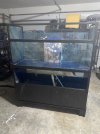becerril17
Member
We are new to the saltwater world and even after watching a ton of videos I’m still confused about a sump.
We currently have a 40g breeder that we are using a canister filter on which may one day change but definitely not anytime soon. The other day I got a 90g tank with approximately 60g sump for free and I’m extremely intimidated by it. It’s needing some TLC and seems like it’ll be a long term project (maybe)
Im posting this in hopes that anyone has any “dumbed down” informational help they could offer or point me in the right direction of some! It would be very very much appreciated!
Thanks in advance
Attached is a photo of the tank. I have not cleaned it yet, that’s the next step. So far all I’ve done is scrape the glass and remove the painted sides.
We currently have a 40g breeder that we are using a canister filter on which may one day change but definitely not anytime soon. The other day I got a 90g tank with approximately 60g sump for free and I’m extremely intimidated by it. It’s needing some TLC and seems like it’ll be a long term project (maybe)
Im posting this in hopes that anyone has any “dumbed down” informational help they could offer or point me in the right direction of some! It would be very very much appreciated!
Thanks in advance
Attached is a photo of the tank. I have not cleaned it yet, that’s the next step. So far all I’ve done is scrape the glass and remove the painted sides.


